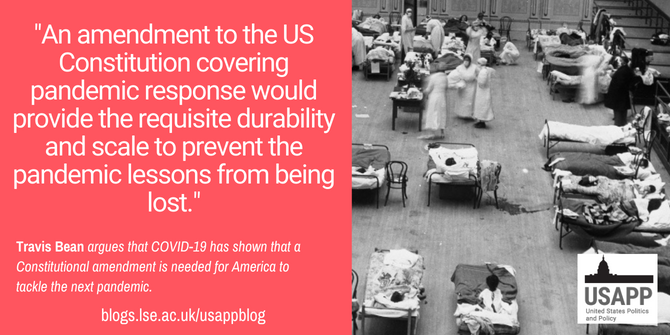The US lacks a robust pandemic prevention framework. Travis Bean offers an account of pandemic history in America to argue that the COVID-19 pandemic should provide an impetus for constitutional amendment that raises the profile and importance of healthcare more generally. For a pandemic response amendment to pass, a strong media campaign, bipartisan legislative backing, and popular support would be needed. Although difficult to achieve, it may be necessary.
For decades, the pursuit of becoming a ‘learning organization’ has driven successful companies, military units, and government departments. From a pandemic response viewpoint, the US Federal government is not such an organization. Much more could be done to learn and apply the lessons of COVID-19 and mitigate the effects of a future pandemic. An amendment to the US Constitution covering pandemic response would provide the requisite durability and scale to prevent the pandemic lessons from being lost.
A pandemic response amendment to the Constitution is needed
The United States Constitution is the Nation’s central governing document. While the people’s welfare is important, in practice the US popular attention has focused on other constitutional themes. Imagine for a moment that the US provided healthcare with the same gusto it executes its national defense strategy.
There are a few perennial debates involving the Constitution. Certainly speech, religion, and firearms come to mind. However, healthcare has had surprisingly little coverage. In fact, from the early days of the US, healthcare was not largely seen as something that Americans owed each other. There have been notable federal advances in healthcare in the last century, but Congress still struggles with implementation of popular healthcare initiatives today as it did in the early 1900s.
A pandemic response amendment is a novel one, but one with a clear textual basis. The general welfare mentioned in the document’s Preamble should include protecting Americans from preventable disease. Also, the due process protection of equal rights under the law and of life itself via Article Five can also be invoked to support a constitutional framework for pandemic response.
Though there is much work needed on the specifics of an amendment, it could contain the following:
- A requirement for the development and maintenance of a national pandemic strategy. This mitigates the risk of a strategy being lost or ignored.
- A clear delineation of roles and responsibilities for pandemic response between the states and the federal government. This will improve operational clarity, particularly during the initial stages of pandemic response.
- Clear guidance on the constitutionality of mask and other PPE mandates. Stating such requirements clearly will make it easier for citizens and businesses to operate during the future pandemics.
COVID-19 measures taken by the government were not permanent
On May 24th , 2020, a New York Times headline said of the Coronavirus: ‘U.S. Deaths Near 100,000, an Incalculable Loss’. About two years later, US deaths had eclipsed one million While many of these deaths may have not preventable, lessons need to be learned from this tragedy. What was done? And, perhaps, what more could have been?
Very little permanent legislation has been passed to protect against another pandemic. My research found thirty-five pieces of enacted legislation to date dealing with COVID-19 or adjacent topics. Some of them were very broad, like the Consolidated Appropriations Act, while others were bespoke like the Combating Pandemic Scams Act. Most of these bills were brief, and they only appropriated funds for the following five-year period.
Among the bills, there were a couple very large pieces of legislation: The Paycheck Protection Acts (both the initial bill and extensions), the CARES Act, and the American Rescue Plan Act. These bills had few parts which established barriers against a future pandemic or created structural changes or sweeping reforms to the US’ public medical structure.

Flu inn Oakland, 1918 by Edward A. “Doc” Rogers, 1873-1960, Public domain, via Wikimedia Commons
How we can learn from pandemic history
The severity of inaction would not be so egregious if it weren’t for similar inaction seen in the wake of the 1918 Influenza Pandemic.
The Congressional ‘Statutes at Large’ for the years during and after the 1918 Pandemic contain a comprehensive list of legislation enacted during that time. The dearth of comprehensive legislation against the pandemic was both reflective of a less involved federal government, and a precursor to later inaction. In October 1918, there was a $1 million allotment (equivalent to nearly $20 million today) to the States to ‘combat and suppress’ influenza. After an initial surge in funding, Congress started an annual routine for Pandemic Prevention appropriations which continued for approximately a decade. Yet the lack of granularity in the measures, and their temporary and monetary nature, did not create structural change. The lessons of the 1918 Pandemic from a legislative standpoint, were not learned.
The pandemic measures from both the 1919 and 2020 pandemic eras were too few and too little. Prior to COVID-19, to be sure, there were teams poised to execute pandemic response plans. But if the experts are hamstrung by an executive that is unable or unwilling to respond, as was the case under President Trump, then nothing happens. There is a need for safeguards and there is a need for structural change.
How to amend the Constitution
Should a change to the Constitution be necessary, there is a way to amend it. The process of amendment is not easy, a supermajority is required among both houses of the Congress, as well as by the state legislatures or by statewide popular votes. It’s hard. But it’s been done twenty-seven times before since the Constitution was ratified in 1783.
There should be no confusion that a pandemic response Constitutional amendment is an extremely difficult undertaking, and perhaps even dead upon arrival in either chamber of the Congress. However tough it may be, it is still a worthwhile effort as it has the potential to save lives in the future. There are a few things that legislators may do to improve the measure’s chances.
By its nature, this amendment has a partisan dimension. The leadership and members of the Democratic Party typically have more trust in science-backed policies. Further, from the onset of the COVID-19 pandemic, Democrats generally supported stricter measures than Republicans. The success of a pandemic response amendment, therefore, is tied to a Democratic majority. This suggests that time is limited. Democrats have slim advantages now, but their fate after the November 2022 mid-terms is uncertain. While Republican chances are eroding slightly, polling suggests they still have the odds for taking the House in the autumn. At the same time, a later Congress would be equally empowered to act. Though a more immediate solution is preferable while the tragedy of COVID-19 is still in our collective consciousness, it would be better to respond later than not at all.
Even with slim majorities in the House and Senate, partisanship is still an obstacle. Republican leadership seems to balk at an objective ground truth on many key issues, for instance calling the January 6 attacks ‘legitimate political discourse’, and only recently inching away from full climate denialism. With this dynamic in mind, should a pandemic response amendment to be successful, a careful strategy is required.
The history of politics and healthcare in the US suggests that the hopes of success in this field must rest on three main pillars: a strong media campaign, bipartisan legislative backing, and popular support. Democrats wishing to advance a pandemic response amendment may wish to ally with both healthcare groups like the American Medical Association and business interest groups like the US Chamber of Commerce. Medical groups have a clear incentive for keeping people healthy, but so do businesses. Though in the early days of the pandemic, certain politicians advocated sacrificing high-risk individuals for the health of the economy, this line of thinking is demonstrably (and morally) flawed. A breadth of academic research demonstrates that initial and strong restrictions may result in better long term economic outcomes. Businesses have a vested interest in the long-term health of the economy and should rally around disease prevention policies that will help to this end.
Assuming a sizable coalition of interest groups and politicians, the next goal must be to wage a media campaign. This would be a time to engage the bully pulpit, and make full use of print, television, and internet media to advocate for a new amendment. For a blueprint of such a movement, one may look to the arguably less popular prohibition movement which led to a short-lived constitutional amendment restricting the purchase of alcohol. Should the pandemic prevention campaign have the desired effect of persuading the public, perhaps right-leaning members of Congress would soften opposition and thus create a narrow avenue for success.
The pathway to success for a pandemic prevention amendment is wrought with pitfalls and makes many assumptions. However, should the US be serious about preventing hundreds of thousands of deaths in the future, the difficult short-term option must be considered to realize vital long-term benefits.
The need for a lasting pandemic prevention plan
As COVID-19’s severity diminishes, we are seeing a return to life as normal. Similarly, many breathed a collective sigh of relief once the worst of the 1918 pandemic was over and launched much of the US into the ‘roaring twenties.’ The more time we put between ourselves and the last pandemic, the less time there is until the next one. This is precisely why the US needs a lasting pandemic prevention framework. The optimal place for that is the US Constitution.
Tragic events like Pearl Harbor and September 11, 2001, resulted in large scale governmental responses. In the same way, the COVID-19 pandemic deserves a stronger and more strategic response. To protect against a future disease-driven mass death event, we must implement a pandemic infrastructure for future generations to follow that is guaranteed by the Constitution. To this end, amending the Constitution may not be easy, but it’s the right thing to do.
- Please read our comments policy before commenting.
- Note: This article gives the views of the author, and not the position of USAPP – American Politics and Policy, nor the London School of Economics.
- Shortened URL for this post: https://bit.ly/3RSR8Kn






